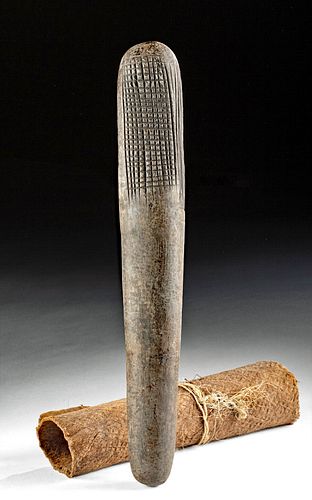Early 20th C. Papua New Guinea Stone Tapa Beater
Lot 165b
About Seller
Artemis Fine Arts
686 S Taylor Ave, Ste 106
Louisville, CO 80027
United States
Selling antiquities, ancient and ethnographic art online since 1993, Artemis Gallery specializes in Classical Antiquities (Egyptian, Greek, Roman, Near Eastern), Asian, Pre-Columbian, African / Tribal / Oceanographic art. Our extensive inventory includes pottery, stone, metal, wood, glass and textil...Read more
Estimate:
$250 - $350
Absentee vs Live bid
Two ways to bid:
- Leave a max absentee bid and the platform will bid on your behalf up to your maximum bid during the live auction.
- Bid live during the auction and your bids will be submitted real-time to the auctioneer.
Bid Increments
| Price | Bid Increment |
|---|---|
| $0 | $25 |
| $300 | $50 |
| $1,000 | $100 |
| $2,000 | $250 |
| $5,000 | $500 |
| $10,000 | $1,000 |
| $20,000 | $2,500 |
| $50,000 | $5,000 |
| $100,000 | $10,000 |
| $200,000 | $20,000 |
About Auction
By Artemis Fine Arts
Jan 21, 2021
Set Reminder
2021-01-21 10:00:00
2021-01-21 10:00:00
America/New_York
Bidsquare
Bidsquare : Ancient / Ethnographic From Around The World
https://www.bidsquare.com/auctions/artemis-gallery/ancient-ethnographic-from-around-the-world-6316
Ancient art from Egypt, Greece, Italy and the Near East, as well as Asian, Pre-Columbian, Native American, African / Tribal / Oceanic, Spanish Colonial, Russian Icons, Fine art, much more! All categories, all price ranges... all legally acquired and guaranteed to be as described or your money back. Artemis Fine Arts info@artemisgallery.com
Ancient art from Egypt, Greece, Italy and the Near East, as well as Asian, Pre-Columbian, Native American, African / Tribal / Oceanic, Spanish Colonial, Russian Icons, Fine art, much more! All categories, all price ranges... all legally acquired and guaranteed to be as described or your money back. Artemis Fine Arts info@artemisgallery.com
- Lot Description
Oceania, central/eastern Papua New Guinea, probably Markham Valley region, ca. early 20th century CE. An elegant tapa beater carved from a single piece of stone of warm taupe hues and accompanied by a piece of tapa cloth. The overall form is tubular with rounded ends, and one side of the beater head is incised with overlapping vertical and horizontal striations creating a cross-hatch pattern which aids in the tapa pounding process. Size (beater): 13.5" L x 2" W (34.3 cm x 5.1 cm); (cloth): 15" L x 9" W (38.1 cm x 22.9 cm)
Tapa is a bark cloth is of great social importance and is often given as a gift; however, prior to the introduction of synthetic fabrics, it was also used for everyday wear. The process for making it is complex and almost ritualistic. First, the paper mulberry tree is cut, the bark is stripped, and the inner bark retained and sun dried, then soaked. After this, the bark is beaten using a stone tool like this one. The sound of the tapa being beaten creates a rhythmic musical backdrop as the work is being done. The strips are then beaten together using plant starch to form a large sheet; the edges of this sheet are then trimmed using a knife or sharp shell. Then, the piece is sometimes painted using stencils made from coconut.
Provenance: private Newport Beach, California, USA collection
All items legal to buy/sell under U.S. Statute covering cultural patrimony Code 2600, CHAPTER 14, and are guaranteed to be as described or your money back.
A Certificate of Authenticity will accompany all winning bids.
We ship worldwide and handle all shipping in-house for your convenience.
#142266Fraying to peripheries of cloth with areas of discoloration. Nicks and abrasions to beater, otherwise intact with nice natural stone inclusions.Condition
- Shipping Info
-
All shipping is handled in-house for your convenience. Your invoice from Artemis Gallery will include shipping calculation instructions. If in doubt, please inquire BEFORE bidding for estimated shipping costs for individual items.
-
- Buyer's Premium



 EUR
EUR CAD
CAD AUD
AUD GBP
GBP MXN
MXN HKD
HKD CNY
CNY MYR
MYR SEK
SEK SGD
SGD CHF
CHF THB
THB















